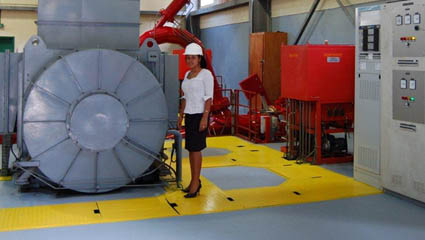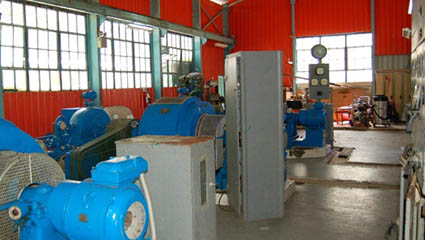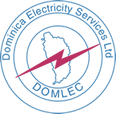The modern generation of electricity is mainly done by the process of electromagnetic induction. In this process a conductor (rotor) is turned (moved), by some mechanical means and given a magnetic field. This will cause electricity to flow through surrounding (neighboring) conductor (stator). The photo is of Domlec’s largest generator. For reference the ladder on the left is about six feet (the height of an average man) above the floor. The rotor, stator and related parts are called the generator. The only thing that varies is the mechanical means of causing the movement. Therefore:
- Diesel Generation: A diesel engine turns the rotor.
- Hydro Generation: Water pressure is applied to a waterwheel that turns a shaft that turns the rotor. A simple example disconnected from the water pipes is shown here:

- Wind Generation: Prevailing natural winds are applied to a windmill structure that turns a shaft that turns the rotor. For reference, the silver box at the bottom is about ten feet high.
- Nuclear Generation and Geothermal Generation: Heat from a controlled nuclear reaction (or heat from inside the earth in the case of geothermal) turns water into steam that turns a turbine that turns a shaft that turns the rotor.

- Beyond the means of turning the rotor in the stator, all forms of electricity generation via induction, work exactly the same.
- Electricity can also be produced by batteries and solar power via chemical reactions and electromagnetic radiation.
- Solar, Wind, and Hydro power are referred to as renewable energy sources because the sources of power are renewed naturally.
- All types of energy sources that are not fossil fuels (diesel and gasoline) are referred to as alternative energy sources.
DOMLEC currently employs diesel and hydro power. Research and or proposals for wind, geothermal, and biogas have been ongoing for some time with varying degrees of success. Private individuals have introduced solar power is being introduced primarily for household water-heating.
The Generation department is responsible for installing, maintaining and repairing all the related equipment including the company vehicles. It is also responsible for initiating research into current and potential generation methods and presents the discoveries and recommendations to the Domlec management for consideration. This consideration process includes, but is not limited to cost, time needed, environmental impacts, sustainability, reliability, human skill set required and available, land usage, useful lifespan.
